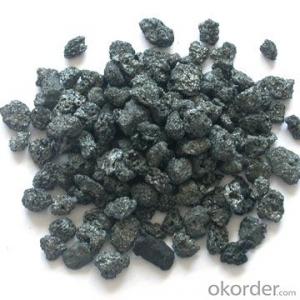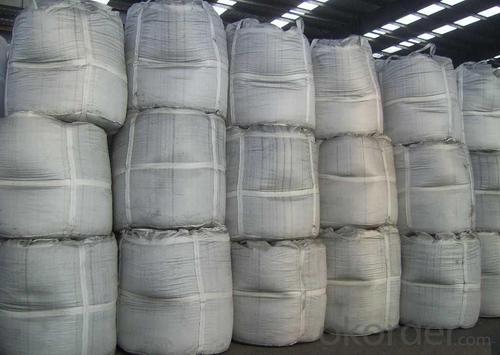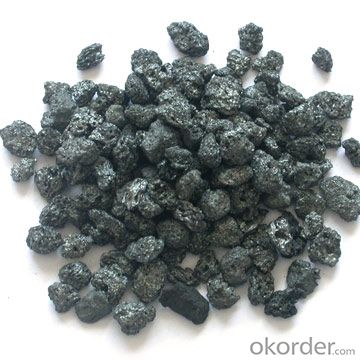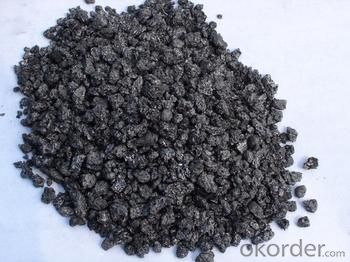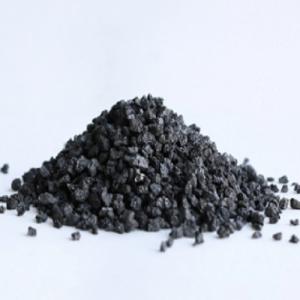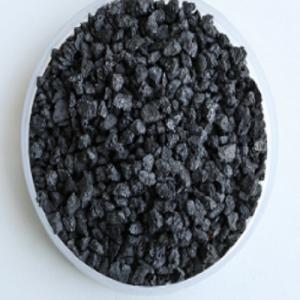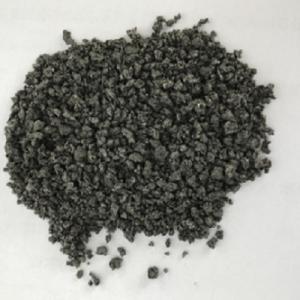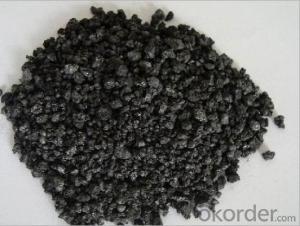Low Price Low Sulfur Good Quality Calcined Petroleum Coke for Sale
- Loading Port:
- Tianjin
- Payment Terms:
- TT OR LC
- Min Order Qty:
- 11 m.t.
- Supply Capability:
- 10000000 m.t./month
OKorder Service Pledge
OKorder Financial Service
You Might Also Like
1.Structure of Calcined Petroleum Coke Description
Calcined Petroleum Coke is made from raw petroleum coke,which is calcined in furnace at a high temperature(1200-1300℃).CPC/Calcined Petroleum Coke is widely used in steelmaking,castings manufacture and other metallurgical industry as a kind of recarburizer because of its high fixed carbon content,low sulfur content and high absorb rate.Besides,it is also a best kind of raw materials for producing artifical graphite(GPC/Graphitized Petroleum Coke) under the graphitizing temperature(2800℃).
2.Main Features of the Calcined Petroleum Coke
High-purity graphitized petroleum coke is made from high quality petroleum coke under a temperature of 2,500-3,500°C. As a high-purity carbon material, it has characteristics of high fixed carbon content, low sulfur, low ash, low porosity etc.It can be used as carbon raiser (Recarburizer) to produce high quality steel,cast iron and alloy.It can also be used in plastic and rubber as an additive.
3. Calcined Petroleum Coke Images
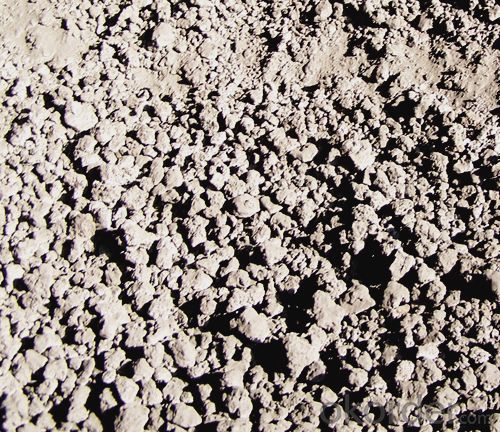
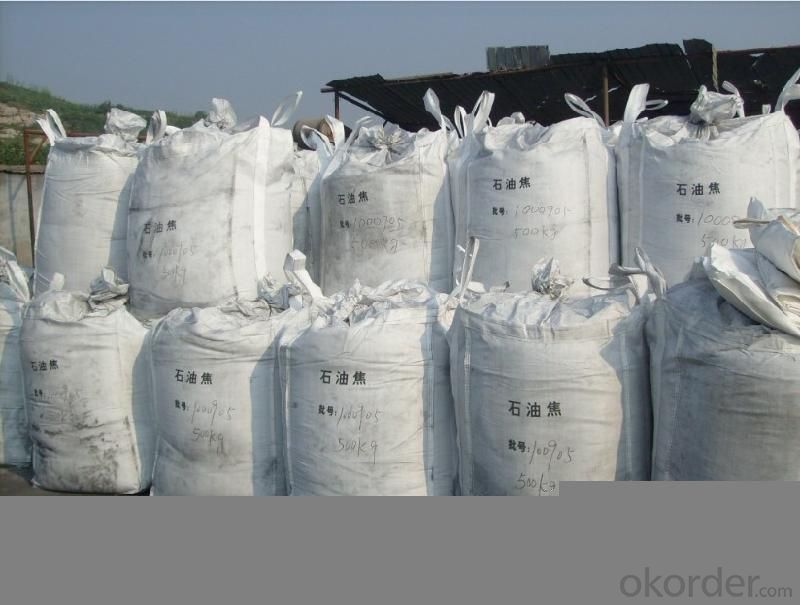
4. Calcined Petroleum Coke Specification
F.C: 90-95
S: 0.2-0.4
A: 3.5-8.5
V.M: 1-1.5
M: 0.5
Size: 1-5mm
5.FAQ of Calcined Petroleum Coke
1). Q: Are you a factory or trading company?
A: We are a factory.
2). Q: Where is your factory located? How can I visit there?
A: Our factory is located in ShanXi, HeNan, China. You are warmly welcomed to visit us!
3). Q: How can I get some samples?
A: Please connect me for samples
4). Q: Can the price be cheaper?
A: Of course, you will be offered a good discount for big amount.
- Q: What are the impacts of carbon emissions on wildlife?
- Carbon emissions have a significant impact on wildlife as it contributes to climate change, leading to habitat loss, changes in migration patterns, and increased vulnerability to disease and extinction. Additionally, the acidification of oceans due to increased carbon dioxide levels affects marine life, disrupting food chains and damaging coral reefs. Overall, carbon emissions pose a grave threat to the survival and well-being of various species.
- Q: How does carbon contribute to the structure of DNA?
- Carbon is an essential element in the structure of DNA as it forms the backbone of the molecule. Carbon atoms in the sugar-phosphate backbone of DNA provide stability and flexibility, allowing the molecule to twist and fold into its double helix shape. Additionally, carbon atoms are also present in the nitrogenous bases, which are the building blocks of the genetic code. Overall, carbon's presence in DNA is crucial for its overall structure and function in storing and transmitting genetic information.
- Q: Is carbon a metal or non-metal?
- Carbon is a non-metal. It is located in group 14 of the periodic table, also known as the carbon group. Non-metals generally have properties opposite to those of metals, such as being poor conductors of heat and electricity, having low melting and boiling points, and being brittle. Carbon, specifically, is known for its ability to form a variety of allotropes, including graphite and diamond. These allotropes have different physical and chemical properties, but they all share the characteristic of being non-metals.
- Q: How does carbon affect the stability of ecosystems?
- Carbon plays a crucial role in the stability of ecosystems as it is a key component of all living organisms. It affects stability primarily through the carbon cycle, where it is exchanged between the atmosphere, plants, animals, and soil. Carbon dioxide, a greenhouse gas, regulates the Earth's temperature and climate. Excessive carbon emissions from human activities, such as burning fossil fuels, contribute to climate change, which disrupts ecosystems and poses risks to biodiversity, water resources, and food production. Additionally, carbon is essential for photosynthesis, the process by which plants convert CO2 into oxygen and organic compounds, supporting the entire food chain. Hence, its availability and balance are essential for maintaining the stability and functioning of ecosystems.
- Q: What is carbon PC?
- Polycarbonate (PC), polycarbonate is a molecular chain containing [O-R-O-CO] chain thermoplastic resin according to the molecular structure of the ester can be divided into aliphatic, alicyclic and aromatic type of fat, which has the practical value of the aromatic polycarbonate, and bisphenol A polycarbonate as the most important, molecular weight is usually 3-10 million.Polycarbonate, English Polycarbonate, referred to as PC.PC is a kind of amorphous, odorless, non-toxic, highly transparent colorless or slightly yellow thermoplastic engineering plastics, has excellent physical and mechanical properties, especially excellent shock resistance, tensile strength, bending strength, compressive strength and high creep; small size is stable; good heat resistance and low temperature resistance, mechanical properties, stability in a wide range of temperature dimensional stability, electrical properties and flame retardant properties, can be used for a long time at -60~120 deg.c; no obvious melting point, a molten state at 220-230 DEG C; the molecular chain rigidity, melt viscosity and high water absorption resin; small, small shrinkage, high precision, good dimensional stability, permeability of films is small; self extinguishing materials; stable to light, but not UV resistance, good weather resistance; oil resistance, acid and alkali resistance, no oxygen acid and amine, Ketones are soluble in chlorinated hydrocarbons and aromatic solvents. They are easy to cause hydrolysis and cracking in water for a long time. Because of their poor fatigue resistance, they are prone to stress cracking, poor solvent resistance and poor wear resistance
- Q: How does carbon affect the formation of air pollution in urban areas?
- Carbon, in the form of carbon dioxide (CO2) and carbon monoxide (CO), plays a significant role in the formation of air pollution in urban areas. Urban areas are characterized by high population density and intense human activities, leading to increased emissions of carbon-based pollutants. The combustion of fossil fuels such as coal, oil, and natural gas releases carbon dioxide into the atmosphere. This greenhouse gas is a major contributor to global warming and climate change. In urban areas, the burning of fossil fuels for energy production, transportation, and heating purposes releases large amounts of carbon dioxide. The accumulation of CO2 in the atmosphere traps heat, leading to the urban heat island effect, which exacerbates air pollution problems. Another carbon-based pollutant, carbon monoxide, is primarily emitted from vehicle exhausts and industrial processes. In urban areas with high traffic congestion, carbon monoxide levels tend to be elevated. This gas is particularly harmful as it reduces the blood's ability to carry oxygen, leading to various health issues, particularly for those with pre-existing respiratory conditions. Furthermore, the presence of carbon in urban areas enhances the formation of secondary air pollutants such as ozone and particulate matter. Carbon reacts with other pollutants, such as nitrogen oxides (NOx) and volatile organic compounds (VOCs), in the presence of sunlight to form ground-level ozone. Ozone is a harmful gas that causes respiratory problems and damages vegetation. Additionally, carbon-based pollutants contribute to the formation of fine particulate matter (PM2.5) in urban areas. These particles are small enough to be inhaled deep into the lungs, causing respiratory and cardiovascular problems. Particulate matter is also responsible for reduced visibility, smog formation, and the deposition of harmful substances onto surfaces. To mitigate air pollution in urban areas, reducing carbon emissions is crucial. This can be achieved through various strategies, including promoting the use of clean energy sources, implementing stricter emission standards for vehicles and industries, and encouraging sustainable transportation options such as public transit and cycling. By addressing carbon emissions, we can effectively reduce air pollution and improve the overall air quality in urban areas, leading to healthier and more sustainable cities.
- Q: What are fossil fuels and how are they formed?
- Fossil fuels are natural energy resources derived from the remains of ancient plants and animals that lived millions of years ago. They are formed through a long process involving the decomposition and conversion of organic matter under high pressure and temperature over geological time. This transformation results in the formation of coal, oil, and natural gas, which are the primary types of fossil fuels.
- Q: What are the impacts of carbon emissions on ecosystems?
- Ecosystems are significantly affected by carbon emissions, and their consequences can be observed at various levels of the food chain. One of the primary effects is the modification of the climate, as carbon emissions contribute to global warming and climate change. This alteration in temperature and weather patterns can disturb ecosystems and result in the depletion of biodiversity. Moreover, increased carbon emissions also play a role in ocean acidification, a process in which seawater absorbs carbon dioxide, leading to a reduction in pH levels. This can have harmful impacts on marine life, especially organisms that possess calcium carbonate shells like corals, mollusks, and specific plankton species. As the acidity of the oceans intensifies, it becomes more difficult for these organisms to produce and maintain their protective shells, ultimately causing a decline in their populations. Additionally, carbon emissions have the potential to influence the distribution and behavior of species. With rising temperatures, certain habitats become unsuitable for some species, compelling them to either migrate or adapt to new conditions. This can disrupt the fragile equilibrium of ecosystems, as some species may struggle to find sufficient resources or face heightened competition for limited resources in their new environments. Furthermore, carbon emissions have a significant impact on the frequency and intensity of extreme weather events such as hurricanes, droughts, and wildfires. These occurrences can result in the destruction of habitats, loss of vegetation, and displacement of species, ultimately affecting the overall well-being and stability of ecosystems. In conclusion, the effects of carbon emissions on ecosystems are profound and far-reaching. It is imperative to reduce these emissions and transition to cleaner sources of energy in order to mitigate these consequences and safeguard the delicate balance of our natural world.
- Q: How is carbon used in the production of pigments?
- Carbon is used in the production of pigments as a black colorant or as a base for creating various shades of gray. Carbon black, which is made by burning or decomposing organic materials, is commonly used as a pigment due to its intense black color. Additionally, carbon can be used to create different pigments by combining it with other elements or compounds, resulting in a wide range of colors for various applications in industries such as paints, inks, and plastics.
- Q: What are the impacts of carbon emissions on indigenous communities?
- The impacts of carbon emissions on indigenous communities are significant and multifaceted. These communities, who often depend on their surrounding environment for sustenance and cultural practices, are particularly vulnerable to the consequences of climate change. Increased carbon emissions contribute to rising global temperatures, leading to more frequent and intense extreme weather events such as droughts, floods, and storms. This directly affects indigenous communities' access to clean water, food security, and the ability to maintain traditional practices like agriculture, hunting, and fishing. Moreover, carbon emissions contribute to the melting of polar ice caps and glaciers, leading to rising sea levels and coastal erosion. This poses a serious threat to indigenous communities living in low-lying coastal areas, displacing them from their ancestral lands and disrupting their cultural heritage. Indigenous communities also face health issues as a result of carbon emissions. The burning of fossil fuels releases harmful pollutants that degrade air quality, leading to respiratory problems and an increased risk of diseases. Additionally, the extraction and processing of fossil fuels often occur on or near indigenous territories, leading to environmental degradation, water pollution, and the displacement of communities. Overall, the impacts of carbon emissions on indigenous communities are profound, undermining their cultural identity, livelihoods, and overall well-being. It is crucial to recognize and address these impacts through sustainable and inclusive climate action, ensuring the protection and empowerment of indigenous communities in the face of climate change.
Send your message to us
Low Price Low Sulfur Good Quality Calcined Petroleum Coke for Sale
- Loading Port:
- Tianjin
- Payment Terms:
- TT OR LC
- Min Order Qty:
- 11 m.t.
- Supply Capability:
- 10000000 m.t./month
OKorder Service Pledge
OKorder Financial Service
Similar products
Hot products
Hot Searches

